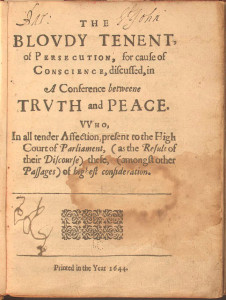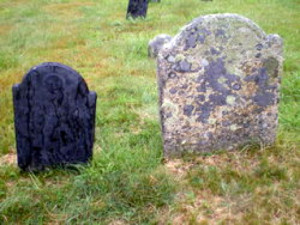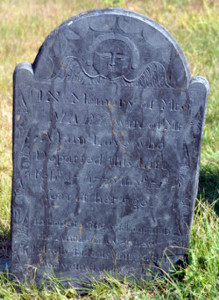Adam and Mary Love, who immigrated to America in about 1730 from County Antrim, Northern Ireland, represent the beginning of our Love ancestor line in the U.S. They settled in Rhode Island, where they established a farm and raised five children to maturity, including our ancestor, the Revolutionary War veteran, Sergeant Robert Love.
The Loves were Scotch Irish. Their ancestors were part of a large relocation program instituted by King James I of England. During the early seventeenth century, he encouraged Protestants from southern Scotland to settle in northern Ireland, in order to neutralize the rebellious Irish and to counter the power of the Roman Catholic church there. A hundred years later, these Scotch-Irish, or “Ulster Scots,” as they were called in England, were suffering economic hardship. Absentee English landlords aggressively pursued short-term economic returns on their Irish holdings with no regard for sustaining the productivity of the land. So, in the early eighteenth century, groups of these farmers organized themselves to immigrate to the new world.
Adam and Mary Love came to America in such a group, including Adam’s brother, Gabriel, his wife, and probably other neighbors and extended family members. They were young – in their late twenties or early thirties – and had their toddler age daughter, Elizabeth, with them. Mary was pregnant with her second child, our ancestor, Robert, who was born possibly on board the ship or soon after they arrived in America.
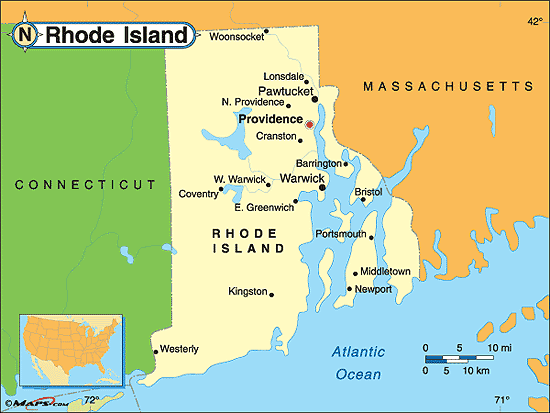 Their destination, Rhode Island colony, had been founded by Roger Williams a century earlier, and was known for its religious toleration and acceptance of a diverse array of immigrants. We don’t know if the Loves chose Rhode Island, or whether they wound up there because the neighboring colonies, Massachusetts and Connecticut, did not want them. Those colonies welcomed only Puritans from England who wanted to live in a theocratic state – in other words, immigrants who were like the people who were already there. The Loves immigrated primarily for economic reasons, not because of religious persecution. But they were no doubt aware that freedom of conscience was the bedrock on which Rhode Island was founded.
Their destination, Rhode Island colony, had been founded by Roger Williams a century earlier, and was known for its religious toleration and acceptance of a diverse array of immigrants. We don’t know if the Loves chose Rhode Island, or whether they wound up there because the neighboring colonies, Massachusetts and Connecticut, did not want them. Those colonies welcomed only Puritans from England who wanted to live in a theocratic state – in other words, immigrants who were like the people who were already there. The Loves immigrated primarily for economic reasons, not because of religious persecution. But they were no doubt aware that freedom of conscience was the bedrock on which Rhode Island was founded.
The Loves settled in central Rhode Island, in the newly established town of Coventry, about twelve miles from the Connecticut border. Adam Love started out by working for an already-established farmer in Coventry.
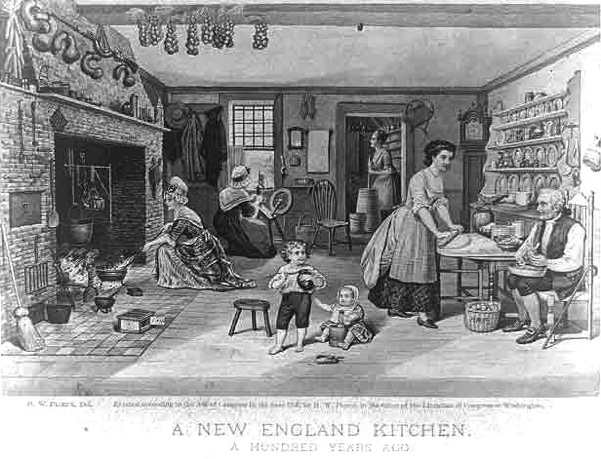
A New England Kitchen

Colonial Rhode Islanders taking produce to market. Some of their farm products would have been sold in the colonies, and others would have been loaded on the ships seen in the background, to be transported to European markets.
By 1738 Adam and Mary had bought land and begun the back -breaking work of creating a farm. Typically, Rhode Island farmers produced apples, corn, onions, dairy products, and sheep for market as well as home use.
Adam and Mary raised to adulthood five children, three boys and two girls. When the boys were grown, their parents bought each of them a farm of their own, as was customary at the time.
Adam Love died in 1765. His gravestone still stands in a small cemetery just across the state line into Connecticut. His gravestone reads: “In the Memory of Mr. Adam Love who Deceased This Life Aug. 10, 1765. Aged 68 years. The sweet remembrance of the just shall flourish when he sleeps in dust.”
Mary Love lived for another ten years, residing mainly on the homestead farm. During that time she had the care of the infant daughter, Olive, of her son, Robert. In an account it appears that she made charges for board and care as follows: “To keeping, bording and finding your child clothes from the year 1760 to the year 1768 five shillings per week, 84 [pounds] 0 shillings, 0 pence. To fore years boarding and cloathing of your child at two shillings per week from the year 1768 to the year 1773, 20 [pounds] 16 shillings, 0 pence”, (McKillop, p. 29). It is hard to convert colonial money to the current day, but a comparison point is that Adam Love paid 2 pounds 10 shillings for a pair of shoes (McKillop, p. 27), the equivalent of two and a half months of board and care when the child was young. When Olive was eight or nine and old enough to help around the farm, the cost of her care was reduced by more than half.
Mary Love died at age 74 and was buried next to her husband. Her gravestone reads: “In Memory of Mrs Mary wife of Mr. Adam Love who Departed this Life Feb. 27, 1776 in ye 74th year of her age. In hope to sing without a sob, The anthem ever new, I gladly bid this dusty gloab And vein delights Adieu.”
Information about Mary‘s charges for boarding her granddaughter points to an interesting aspect of research on colonial ancestors. For Mary and Adam Love, we have records of several court actions, which have been preserved in Rhode Island since colonial times, but the records themselves don’t tell us the social and legal context within which these actions occurred. So we know, for example, that Adam and Mary were “warned out” of Coventry, RI, as potential vagrants soon after they arrived there. However, we have no context in the record itself for understanding this legal action. Our first conclusion might be that they were considered undesirable residents. However, colonial towns operated under the English Poor Law, which required them to care for town residents who became destitute. To get around this, towns commonly gave a “warning out” notice to newcomers, as a legal statement that these persons were not yet residents, and so not eligible for potential Poor Law benefits.
Similarly, we know what Adam Love paid for shoes because he was sued for non-payment, but once again we have no context. So we don’t know if he was trying to get away without paying the bill or if it was all a misunderstanding. The record of Mary‘s charges to her son for the care of his daughter also raises questions. Was this common practice at the time? Or possibly – my own theory – a legal record created so that when she died, the cost of board could be deducted from Robert’s share of the inheritance. Colonial legal records give us a window into colonial life, but also leave us with unanswerable questions.
How you are related to Adam and Mary Love
On your personal Ancestor Fan, go to Levi Love on the outermost ring. Then click here to open the Levi Love Ancestor Fan. Adam and Mary Love are in the blue section, third ring out.
References
www.findagrave.com for pictures of the graves.
Love, William DeLoss. Love Family History. Unpublished manuscript. Hartford, CT, about 1918.
Jones, Maldwyn. “Scotch-Irish.” In Thernstrom Stephan, ed. Harvard Encyclopedia of American Ethnic Groups. Harvard University Press, Cambridge, MA. 1980.
McKillop, Dorothy, and Love, Mary Anne. Love Family History. Unpublished manuscript, Seattle and Fairfax, VA.

